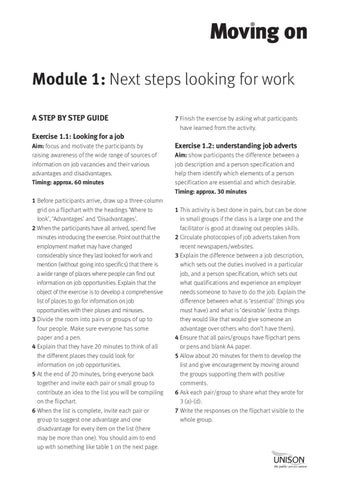Module 1: Next steps looking for work A STEP BY STEP GUIDE
7 Finish the exercise by asking what participants have learned from the activity.
Exercise 1.1: Looking for a job Aim: focus and motivate the participants by raising awareness of the wide range of sources of information on job vacancies and their various advantages and disadvantages. Timing: approx. 60 minutes 1 Before participants arrive, draw up a three-column grid on a flipchart with the headings ‘Where to look’, ‘Advantages’ and ‘Disadvantages’. 2 When the participants have all arrived, spend five minutes introducing the exercise. Point out that the employment market may have changed considerably since they last looked for work and mention (without going into specifics) that there is a wide range of places where people can find out information on job opportunities. Explain that the object of the exercise is to develop a comprehensive list of places to go for information on job opportunities with their pluses and minuses. 3 Divide the room into pairs or groups of up to four people. Make sure everyone has some paper and a pen. 4 Explain that they have 20 minutes to think of all the different places they could look for information on job opportunities. 5 At the end of 20 minutes, bring everyone back together and invite each pair or small group to contribute an idea to the list you will be compiling on the flipchart. 6 When the list is complete, invite each pair or group to suggest one advantage and one disadvantage for every item on the list (there may be more than one). You should aim to end up with something like table 1 on the next page.
Exercise 1.2: understanding job adverts Aim: show participants the difference between a job description and a person specification and help them identify which elements of a person specification are essential and which desirable. Timing: approx. 30 minutes 1 This activity is best done in pairs, but can be done in small groups if the class is a large one and the facilitator is good at drawing out peoples skills. 2 Circulate photocopies of job adverts taken from recent newspapers/websites. 3 Explain the difference between a job description, which sets out the duties involved in a particular job, and a person specification, which sets out what qualifications and experience an employer needs someone to have to do the job. Explain the difference between what is ‘essential’ (things you must have) and what is ‘desirable’ (extra things they would like that would give someone an advantage over others who don’t have them). 4 Ensure that all pairs/groups have flipchart pens or pens and blank A4 paper. 5 Allow about 20 minutes for them to develop the list and give encouragement by moving around the groups supporting them with positive comments. 6 Ask each pair/group to share what they wrote for 3 (a)-(d). 7 Write the responses on the flipchart visible to the whole group.
